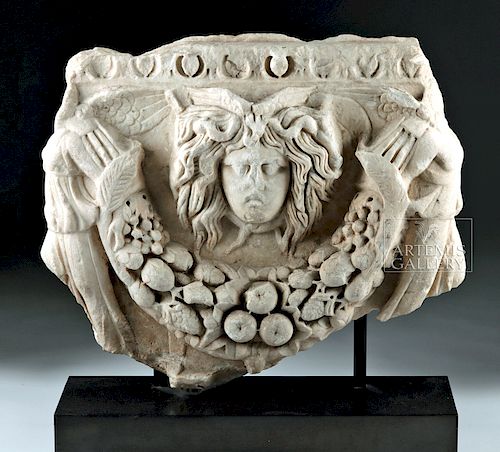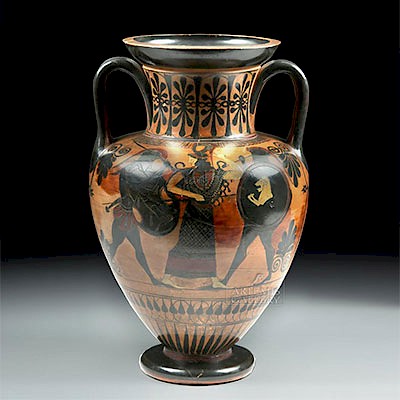Large Roman Marble Sarcophagus Panel with Medusa
Lot 24e
About Seller
Artemis Fine Arts
686 S Taylor Ave, Ste 106
Louisville, CO 80027
United States
Selling antiquities, ancient and ethnographic art online since 1993, Artemis Gallery specializes in Classical Antiquities (Egyptian, Greek, Roman, Near Eastern), Asian, Pre-Columbian, African / Tribal / Oceanographic art. Our extensive inventory includes pottery, stone, metal, wood, glass and textil...Read more
Estimate:
$20,000 - $30,000
Absentee vs Live bid
Two ways to bid:
- Leave a max absentee bid and the platform will bid on your behalf up to your maximum bid during the live auction.
- Bid live during the auction and your bids will be submitted real-time to the auctioneer.
Bid Increments
| Price | Bid Increment |
|---|---|
| $0 | $25 |
| $300 | $50 |
| $1,000 | $100 |
| $2,000 | $250 |
| $5,000 | $500 |
| $10,000 | $1,000 |
| $20,000 | $2,500 |
| $50,000 | $5,000 |
| $100,000 | $10,000 |
| $200,000 | $20,000 |
About Auction
By Artemis Fine Arts
Oct 11, 2018
Set Reminder
2018-10-11 10:00:00
2018-10-11 10:00:00
America/New_York
Bidsquare
Bidsquare : Exceptional Antiquities | Ethnographic Art
https://www.bidsquare.com/auctions/artemis-gallery/exceptional-antiquities-ethnographic-art-3500
An important one-day auction featuring museum-worthy examples of classical antiquities, ancient and ethnographic art from cultures encompassing the globe. Artemis Fine Arts info@artemisfinearts.com
An important one-day auction featuring museum-worthy examples of classical antiquities, ancient and ethnographic art from cultures encompassing the globe. Artemis Fine Arts info@artemisfinearts.com
- Lot Description
Roman, Imperial Period, ca. 1st to 3rd century CE. Finely carved in low to high relief - a sizeable section of a marble sarcophagus depicting the head of Medusa with a garland of fruit suspended below, a decorative frieze above, and females donning one-shouldered garments and striding forward to each side. Renderings of Medusa by the ancients were traditionally used to ward off evil, hence they were ideal for sarcophagi intended to protect the deceased for all eternity. The juxtaposition of plentiful fruit and flora - grapes, apples, pinecones, and leaves - in the garland symbolizes a promise for eternal bountiful fruition and abundance. Although this piece possesses some age wear as shown, it is remarkable that it survived the onslaught of the early Christian campaigns that destroyed so many exceptional examples of so-called pagan art! Size: 24" W x 21.25" H (61 cm x 54 cm); 24.25" H (61.6 cm) on included custom stand.
The word sarcophagus literally means "flesh-eater" in Greek. Sarcophagi were coffins used throughout the Roman Empire beginning in the second century CE when inhumation burials became more popular than cremation practices of the Republican and early Imperial periods. The rise in sarcophagi usage was inspired by earlier Etruscan and Greek models. This example came from a particularly luxurious sarcophagus as it was made from marble. Less elite examples were made from other stones, wood, and lead. A wonderful section of a marble sarcophagus intended for an elite individual of ancient Rome.
How ironic that the sculptor created a marble (stone) version of this mythical Gorgon monster with writhing serpents in her wavy coiffure whose mere gaze could transform onlookers to stone! Throughout the ages, Medusa has been immortalized in countless works of art. Some of you may be familiar with the dramatic interpretations by Michelangelo Merisi da Caravaggio, Peter Paul Rubens, Benevenuto Cellini, Gianlorenzo Bernini, Rene Lalique, Antonio Canova, and the list goes on. These artists of the Renaissance, Baroque, and Neoclassical eras were inspired by ancient renderings of Medusa like this example.
Provenance: private East Coast, USA collection
All items legal to buy/sell under U.S. Statute covering cultural patrimony Code 2600, CHAPTER 14, and are guaranteed to be as described or your money back.
A Certificate of Authenticity will accompany all winning bids.
We ship worldwide and handle all shipping in-house for your convenience.
#139475Losses to peripheries, top central apple, and high pointed areas of sarcophagus panel and frieze above as shown. Abrasions to face, coiffure, and other high pointed areas. Still remarkable to find a section of this size and clarity in the carving.Condition
- Shipping Info
-
All shipping is handled in-house for your convenience. Your invoice from Artemis Gallery will include shipping calculation instructions. If in doubt, please inquire BEFORE bidding for estimated shipping costs for individual items.
-
- Buyer's Premium



 EUR
EUR CAD
CAD AUD
AUD GBP
GBP MXN
MXN HKD
HKD CNY
CNY MYR
MYR SEK
SEK SGD
SGD CHF
CHF THB
THB
















